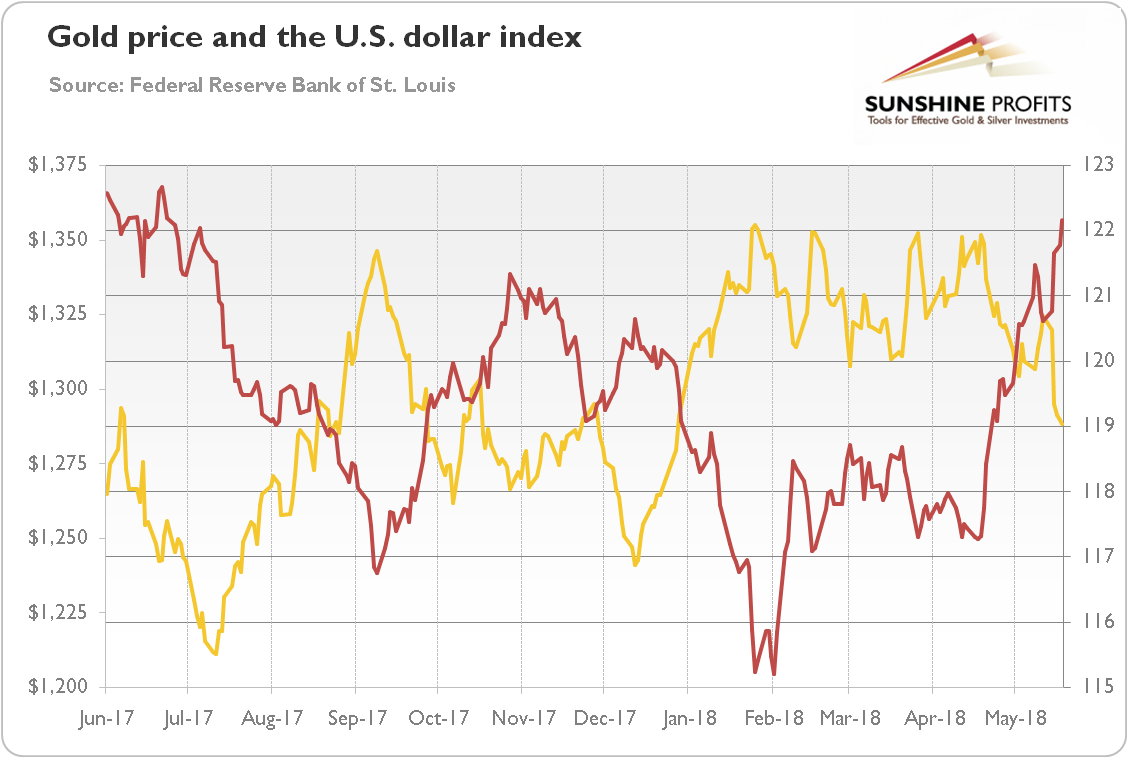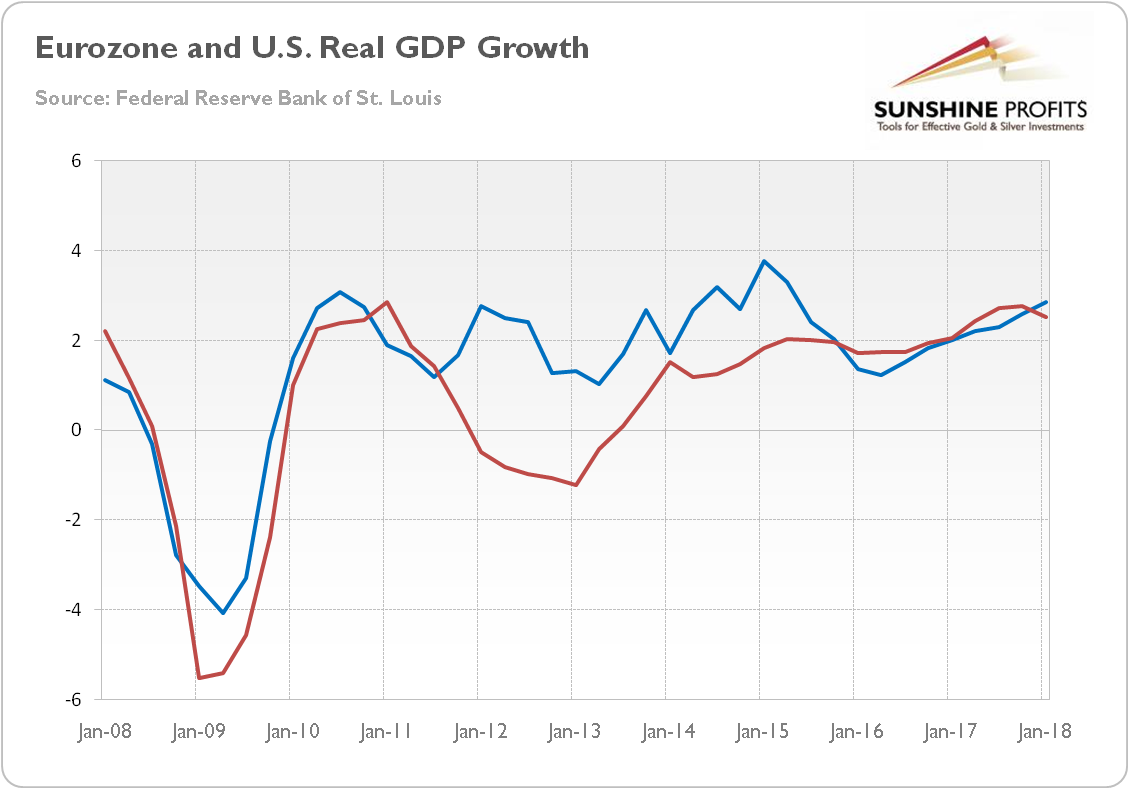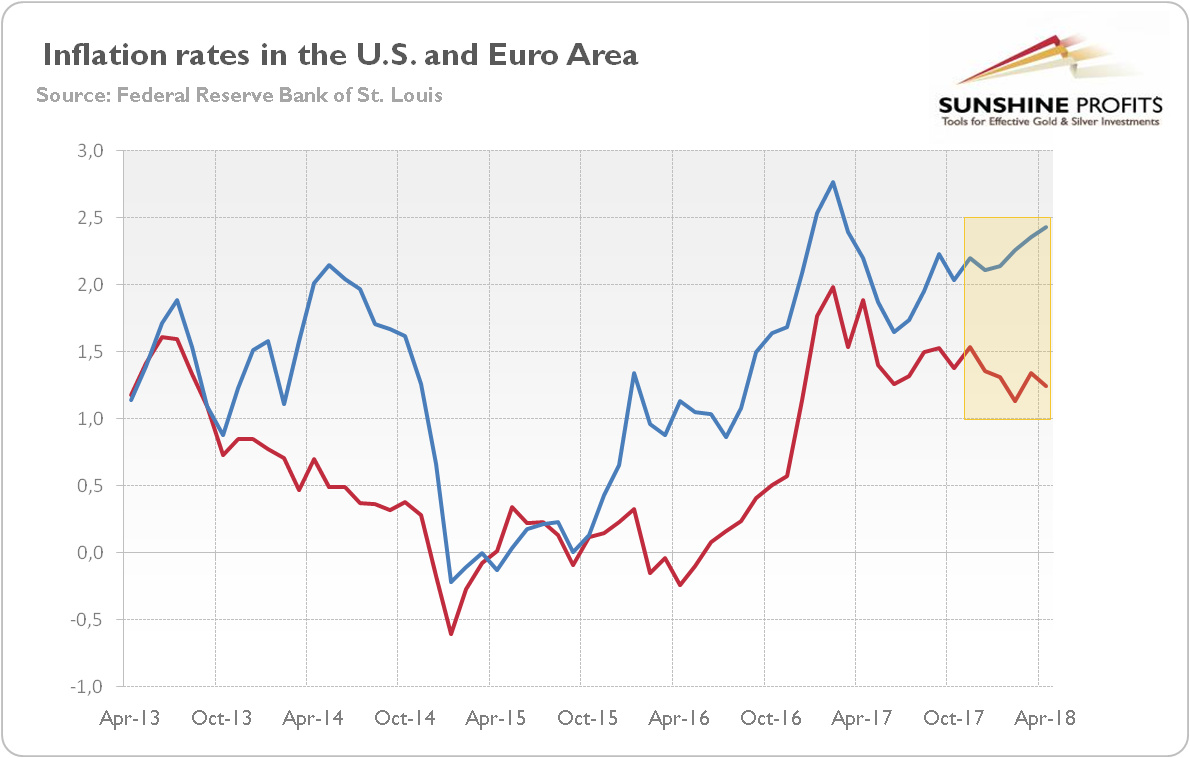On the macroeconomic front, the rapid strengthening of the U.S. dollar has been the most important development since the latest edition of the Market Overview. Let’s mull over the reasons behind it and its potential effects on the gold market.
As one can see in the chart below, the U.S. dollar appreciated 6 percent against the broad basket of currencies since its bottom from the early February. But the real rally started in mid-April. Since April the 17th, the index rose from 117.27 to 122.16 on May the 18th, for more than 4 percent.
Chart 1: Gold prices (yellow line, left axis, London P.M. Fix, in $) and U.S. Dollar Index (broad & trade weighted, red line, right axis) from June 2017 to May 2018.

What caused the greenback to rise? The standard answer is the divergence in monetary policies among systemically important central banks. Only the Fed awoke and started to unwind its balance sheet and hike the federal funds rate, while other major central banks are still into their winter sleep of loose monetary policy.
It’s true, but the U.S. central bank did not begin normalizing its monetary policy yesterday, but a few years ago. And the greenback depreciated significantly last year, despite all the Fed’s actions.
So it seems that something else must be working here. But what? You see, interest rate differential is not everything. The growth and inflation differentials also matter. Let’s look at the chart below. Until the end of 2017, the pace of economic growth has been higher for the eurozone. But in Q1 2018, the U.S. outpaced its major peer.
Chart 2: The real GDP growth for the Eurozone (red line) and the real GDP growth for the U.S. (blue line) from 2008 to Q1 2018 (percent change from the year ago).

Hence, as Mohamed A. El-Erian pointed out, the catalyst of the dollar’s recent appreciation was “growing, and less favorable, divergence between economic data and expectations in the rest of the world.” In short, growth momentum has weakened in Europe. It may be the case that the strength in the euro has finally hurt growth in the eurozone, which relies on exports much more than U.S. To be clear, the growth in the eurozone is still nice, but below the renewed expectations. The appetite grows with eating.
Let’s analyze one more chart. It paints the annual inflation rates (measured by CPI) in the U.S. and in the eurozone. As you can see, from Q2 2016 to the end of 2017, inflationary dynamics in both economies have been similar. The inflation rate in the eurozone was smaller all the time, but it moved in tandem with its American counterpart (and sometimes it grew even faster). But this year, we see the divergence: U.S. inflation has been accelerating, while the momentum in the eurozone has weakened.
Chart 3: The CPI rate year-over-year for the U.S. (blue line) and the Eurozone (red line) from April 2013 to April 2018.

We know, inflation should be bad for a currency, but we live in strange times, when inflation is awaited by investors as a sign of economic recovery and as an indication that the central banks will speed up the normalization of monetary policy.
And, of course, the eased rhetoric about the trade war between the U.S. and China helped the U.S. dollar, while the populist program adopted by the winning populist parties in Italy hurt the euro. Hence, there is less capital flowing into EU, and some funds have actually outflowed, lifting the greenback against the euro.
There is also another possible explanation that we discussed last year. Namely, USD Index’s reaction to the series of interest rate hikes could have been simply delayed, just like it was the case from 2002 to 2005. The history tends to rhyme and this time the rhyme seems to be loud and clear.
What does it all mean for gold? Well, economic factors should continue to support the strengthening of the U.S. dollar. The interest rate differential has been here for some time. But now the growth and inflation differentials are also with us. The capital may continue to inflow to America, partially because of Trump’s tax reform and repatriation of funds. And the increase in capital spending should support the productivity and economic growth, also helping the greenback.
To be clear, it does not mean that the U.S. dollar has to move upward all the time. After all, the business cycle and monetary normalizing is more advanced in America, so there is more potential for the eurozone. However, until the ECB undertakes more decisive steps to remove its monetary accommodation, we expect the EUR/USD exchange rate to weaken. This is, of course, bad news for gold, which is positively correlated to the euro’s strength and negatively correlated with the U.S. dollar’s fate.
If you enjoyed the above analysis and would you like to know more about the fundamental outlook of the U.S. dollar and the gold market, we invite you to read the June Market Overview report. If you’re interested in the detailed price analysis and price projections with targets, we invite you to sign up for our Gold & Silver Trading Alerts. If you’re not ready to subscribe yet and are not on our gold mailing list yet, we urge you to sign up. It’s free and if you don’t like it, you can easily unsubscribe. Sign up today!!
Thank you.
Arkadiusz Sieron, Ph.D.
Sunshine Profits‘ Gold News Monitor and Market Overview Editor
Gold News Monitor
Gold Trading Alerts
Gold Market Overview


